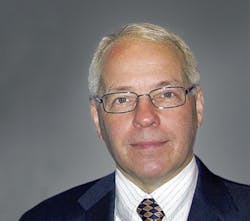Executive Editor
In a contentious U.S. election season, Bill Gates hopes that come November, all candidates will agree on America’s unparalleled capacity for innovation. In an April 18 blog post at Reuters titled “America’s secret weapon,” he wrote that investment in innovation creates jobs at home and fights poverty in the poorest countries, adding, “It offers the next president a tremendous opportunity to help people in America and around the world.”
Of course, a key issue is how to achieve innovation—it can’t be ordered from an online shopping service. But speaking at The Vision Show May 4 in Boston, Leo Baldwin, futurist and inventor, had three specific suggestions: a successful innovation must be novel, it must be useful (not merely fun), and there must be a reasonable way to implement it.
Baldwin, who recently rejoined Amazon (he noted the ideas he was presenting were his own), said that during an earlier stint with the company, the idea of a flexible Kindle reader arose. That might be fun—the Kindle mimics paper, which is flexible. But many people given a sheet of paper look for a way to support it in a comfortable reading position—supporting it on a hardcover book, perhaps. Further, the e-ink used in the Kindle would not perform well in a flexible display. The concept was novel but not necessarily useful or realizable.
Baldwin, who holds 50 U.S. patents finding use in applications ranging from breweries to silicon fabs, then asked, why innovate? The short response, he answered, is “innovate or die.” Sears should have been Amazon, he said. After all, the company had mastered the information superhighway of its time: catalogs, the telephone, and the postal service. The company failed to adapt and is shrinking.
To innovate, said Baldwin, “Be open to new ideas—that’s the first battle.” A corollary is “Let go of old ideas.” Also “reward failure.” That’s not to say “reward incompetence,” he emphasized, but it is appropriate to reward people who take a calculated risk at a moonshot project.
He then commented on diversity: gender, ethnicity, and age, of course, and going beyond legal requirements. An innovative team needs young people with new ideas and older people (who already have made mistakes) to guide them.
An innovative team also should be diverse with respect to work style, he said. An innovative team needs relational thinkers (messy-desk people) as well as hierarchical thinkers (clean-desk people). The former (people like Einstein) will generate the big, breakout ideas; the latter will be innovative at the margins, handling tasks like generating a bill of materials, handling version control, or making gradual process improvements.
Further, he said, don’t tailor the team to your problem (another way of emphasizing diversity). Don’t precategorize the problem. Don’t assign only software engineers to software problems and hardware engineers to hardware problems. A problem that might at first seem to be a software problem might in fact be better solved using an FPGA. A problem that might lend itself to cloud computing may be better solved using a local DSP or ASIC, or vice-versa.
In addition, he advised against embedding a solution in your problem statement. A CEO, he said, might see a presentation on lasers and then specify a package-tracking solution using lasers. The problem, Baldwin emphasized, is to develop a better package-tracking solution. Lasers may or may not be a part of the optimal solution—that’s up to the innovation team to determine.
Baldwin’s recommendations fit well within a company, but government also has a role to play. As Gates emphasized in his Reuters blog post, government should not pick winners and losers—markets will do that. Governments, instead, should make targeted investments in support of entrepreneurs.
About the Author

Rick Nelson
Contributing Editor
Rick is currently Contributing Technical Editor. He was Executive Editor for EE in 2011-2018. Previously he served on several publications, including EDN and Vision Systems Design, and has received awards for signed editorials from the American Society of Business Publication Editors. He began as a design engineer at General Electric and Litton Industries and earned a BSEE degree from Penn State.

